THE DOMINICAN SCHOOL OF ST. ANNE OF KERNABAT
The belief that children best learn the truth when they are surrounded by beauty is what, eight years ago, inspired a Congregation of Dominican teaching sisters to accept a 16th-century chateau in ruins on the condition that they turn it into a school. In taking on the restoration of the ancient chateau of the lords of Kernabat, in Celtic Brittany, the Dominicans of the Holy Name of Jesus were living the words of Pope St. Pius X, written nearly 100 years before to the superiors of the Congregation. They had written to ask counsel, whether to flee an anti-Catholic France or remain disguised as laywomen to continue their teaching in secret. He wrote back to them that "Children's souls are well worth heroic sacrifices made on their behalf." The Sisters remained.
Since their foundation in 1800, the Sisters had already been living by the same principle. They considered that the souls of children were well worth the sacrifice of the religious vows, devoting their lives to the education of young girls in the chaos after the Revolution. They carefully perfected a curriculum in harmony with the child's development, drawing her mind and will to understand and embrace the true and the beautiful. All this in an atmosphere of purity and honesty that would be for the girls an oasis in the midst of an increasingly hostile world.

The east wing and orangerie, BEFORE (1996).
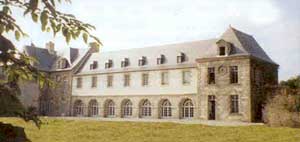
The east wing and orangerie, AFTER (2003).
In 1975, a few dozen of these Dominicans considered that children's souls were well worth the sacrifice of fleeing a Congregation infected by Modernism, of leaving everything to start again on the charity of the faithful. They accepted every sacrifice to cling to the traditional Faith and the Mass of all time, alongside Archbishop Lefebvre who never ceased to encourage and support them. They returned his fidelity by weathering with him the storm that broke after the consecrations of 1988 and the defections that followed.
Yet, the task of handing down a complete Christian education in the middle of a cultural battlefield called for extraordinary measures of defense and counterattack, and new sacrifices. From their first foundations, the superiors decided that a curriculum so entirely opposed to the falsehood and ugliness of the modern world needed more than ever before to be reinforced by the outward beauty of the school itself. They wanted the very walls of the school to bear witness to civilization and harmony. The Dominicans knew that the world was doing everything it could to bombard their children with absurdity, and so they counterattacked by founding schools whose buildings and curriculum would come together like body and soul, forming a whole that made perfect sense. They wanted the children to be surrounded with an education in brick and stone, and to understand the importance of Christian culture merely by stepping within the gates of the property.
In the first years after leaving the old Congregation, the Sisters were obliged to teach school in close quarters along a winding street in the medieval city of Fanjeaux, an hour from Toulouse. There could not yet be any question of transforming the surroundings to correspond to the education. There were no "school grounds" and some of the classrooms as well as the dormitories for the handful of boarders were scattered around the village, meaning nuns and children had to make periodic treks through the streets of Fanjeaux.
However, St. Dominic, too, had made Fanjeaux his first field of action, and for eight years his headquarters were a few blocks away from where the exiled Dominican Sisters found their first shelter and struggled to run a tiny school. He must have approved of his daughters' work, because he found benefactors to help them relocate down the hill from the village in a slightly run-down but stately manor house over 100 years old.
By the purchase of the manor and its outbuildings in 1977, the Sisters set the tone for all of their future foundations. The transformation and restoration of the old farm-buildings in the middle of wheat fields and sunflowers, into something suitable for a school, is an ongoing effort, especially as the school has grown; yet the Sisters remained consciously faithful to the traditional architecture of the region and the aesthetic appeal of the whole. At every subsequent foundation, it might well have been easier to build something new and economical, throwing together four walls and a roof to hold out the rain. Even when they came to America to start a foundation in the hills of Idaho, where no chateaux or manor houses were waiting to be restored, every effort was made to create a school environment that would be a thing of beauty–simple and unpretentious, yet a lesson in good taste.
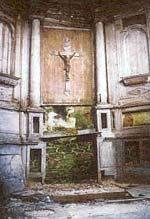 |
|
|
oratory, BEFORE
|
The first daughterhouse was in the Gallo-Roman village of Saint-Macaire, in the region of Bordeaux. It was built in the 1300's as a Franciscan convent, and the Dominicans brought it back to life in 1982. Foundations came rapidly one after the other as new vocations swelled the ranks of the Congregation and parents from the different regions of France clamored to have their own school. The manor house in Romagne, built in the 1800's, was renovated and transformed into a school in 1983. In 1985, the Dominicans received Cressia Castle, towering over a valley in the Jura mountains, near Switzerland. Its oldest fortifications date from the 15th century, but it was restored in the 20th century to become a home for the elderly, because Cressia is famous for its clean mountain air; the Sisters continued the renovations for the benefit of a much younger clientele. 1990 brought the Sisters north to Normandy, where they restored the manor house of Saint-Manvieu, built in the 17th century.
The sound of hammering and the dust of renovation never seems to have hindered the work of the Sisters or the children's learning; on the contrary, the girls take pleasure in being present at the re-creation of their own school. Nor are they passive bystanders; there have always been plenty of ways for everyone to pitch in and be a part of the new foundation, as the girls learned firsthand what a work of value demands in labor and determination.
Word traveled fast in the 1970's and 1980's about the young Congregation of Fanjeaux, whose roots were so firmly established in the past. Word traveled around Europe, and all the way to the United States. For the first American young women to entered Fanjeaux in the 1980's, the sacrifice of the vows included for them the sacrifice of their homeland, and they came fully prepared to live out their vocations in France. Yet Archbishop Lefebvre had for years urged the Dominican Sisters to found a school in America for American girls. So it was that in 1991, seven Dominicans arrived in Post Falls, Idaho, with nothing but seven suitcases and 7,000 pine trees, ready to continue the mission of the Congregation across the Atlantic.
With the foundation in the United States slowly getting to its feet and the first graduating class just entering their junior year, the students at Post Falls found themselves called into the ranks to help their sisters in France. All six of the Dominican foundations pulled together, with their prayers and bake sales and Lenten offerings, to encourage a small contingent of Sisters with perhaps the most difficult mission to date. Providence had offered the Dominican Sisters of Fanjeaux the chateau of Kernabat to turn into a school for the young girls of Brittany.
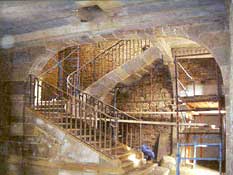 |
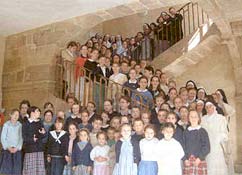 |
|
|
Stairway, BEFORE
|
Stairway, AFTER
|
It was clear that taking on the project would involve a phenomenal effort of restoration. The most striking building on the estate was the chateau itself, whose first stone was laid in 1591 by Captain René d'Acigné and his son Charles, "Knight of the Order of the King." It was majestic but dilapidated. Its main wing faced the west and was flanked by two pavilions, north and south; behind the north pavilion, another wing extended perpendicularly to the east. A few years before, the floor beams had been removed between the different stories of the main wing to relieve the failing walls; the whole was still upright, but the south pavilion in particular was beginning to crumble. Of the east wing, only the gallery of arches remained, leading to the oratory. The chapel's tribune, to which the master of the house once passed directly from the upper level of the chateau, now opened out into empty space, over a floor of random stones and ivy.
A farmhouse and bakery on the property were little more than rubble in 1996, although their original layout could still be traced. The dovecote, one of the last still standing in Brittany, predates even the chateau by nearly a decade. Its presence alone indicates the size of the original estate, since after 1580 a man could only possess a dovecote if the total acreage of his estate amounted to a surface area requiring at least 300 days' work for a single man; the number of doves then corresponded to the number of acres. In 1996, a gaping hole on one side meant pressure on the remaining structure would join weather and vegetation in accelerating its decay.
The family d'Acigné had consulted the king's gardener, Le Notre, to design a plan for their new home; Kernabat was to rival Versailles. They followed his plan for the surrounding park and for the Commons building, to the west of the chateau. The famous gardens had long since disappeared, but one still entered the estate through a gateway of twin pillars, each fronted by matching Corinthian columns; a pair of wooden lions once crowned the whole and greeted visitors to one of the grandest properties of Brittany.
The Dominicans recognized the enormous difficulties involved in a restoration of the chateau. Yet, the beauty of the finished work stood out even stronger in their minds: resurrecting an architectural masterpiece to enclose a school of living tradition, in the larger context of resurrecting Catholic culture. The extraordinary benefit for their students of learning in such an environment was, for the Sisters, well worth the burden of the restoration. They confided themselves to Divine Providence and the proven generosity of their friends and benefactors, and accepted the challenge.
The first object of the restoration was the "Commons," a coach-house or lodging for the servants. This building had been reworked in 1901 so that its state was less critical when it was offered to the nuns and could provide the most immediate shelter for a school. Dormitories, cells for the Sisters, classrooms, a refectory and a small kitchen were all improvised in the vast rooms of the former lodging. Workmen came for everything involving construction, but Sisters and students worked side by side cleaning, washing windows, plastering, painting, moving beds and desks...
In 1998, the foundation stone was laid for the Chapel of the Holy Name of Jesus. A saintly Dominican priest, Fr. de Chivré, a great friend of Archbishop Lefebvre and a spiritual guide to the Sisters, used to tell them, "Above all things, teach the children that the first place is the place you give to God." The Blessed Sacrament was to receive the place of honor at Kernabat, facing the Commons, to the south of the chateau. A traditional Breton design was chosen for the chapel, with a sloping slate roof and internal walls of hemp and lime plaster, to remain faithful to the rest of the estate. In 2003, the students beamed as they helped welcome visitors to the dedication of their own new chapel.

The farmhouse, BEFORE.
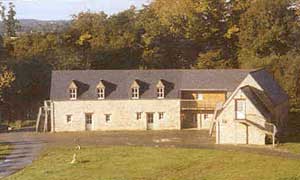
The farmhouse, AFTER.
The bakery and its massive old oven were restored according to their original layout, using traditional labor skills and materials. It now shelters the school's chaplain. The farmhouse, too, was fully restored with sturdy Breton stone walls and a slate roof, with whitewashed hemp and lime interiors for the classrooms. It is dedicated to St. Yves, the lawyer, patron of Brittany.
Most formidable of all would be the restoration of the chateau itself. In December 1999, the south pavilion threatened to collapse; it was stayed by well-placed wooden supports, days before the most violent tempest to pass through Brittany in years. An earthquake in 2002 left no damage, either, thanks to the preventative measures taken by the Sisters, awaiting the day when a full restoration of the pavilion could be made.
The restoration as such began with the galleries of the east wing. They were meant as a sort of greenhouse, to protect the estate's little orange grove; the Sisters consolidated the arches and installed large glass doors to create a bright and open refectory for the girls. They entirely rebuilt the second level of the east wing into a vast room for activities and theater, restoring at the same time the old entry into the tribune of the oratory.
Moving west to the main wing, restoration of the north pavilion began; the roofs on this wing had been removed with a gigantic crane capable of lifting up to 700 tons, in order to eliminate all danger of collapse as workmen consolidated the walls, before putting the roofs back on. The pavilion houses the new modern kitchen, finally operable in 2003, as well as the Sisters' community room. Eventually all three stories of the chateau's main wing and pavilions will be dedicated to dormitories for the students and cells for the Sisters. Libraries for the Sisters and students will eventually be moved into the stately, sunny rooms on the second floor, while workshops and activity rooms will be moved to the large basement.
Only the south pavilion of the main wing has yet to be renovated, with completion planned for 2005. The pavilion is in a deteriorating condition so a prompt overhaul is required in order to prevent further structural damage. However, with the end finally in sight, the work has slowed to a halt. The Sisters and their students are actively seeking sponsors, anyone who can help them, either in the form of donations or loans, to complete the School of St. Anne of Kernabat.
One hundred years have passed since the Superiors of the Congregation of the Holy Name of Jesus asked Pope Pius X for counsel, seeking to remain faithful to their mission under the attacks of a hostile government. As the storm of Modernism broke over the Church and swept away all that remained of a Catholic society, the Dominicans of the Holy Name of Jesus of Fanjeaux clung to the words of the holy pope to fulfill the same mission on the cultural battlefield. They have acted on the belief that "the souls of children are well worth heroic sacrifices" necessary to make Catholic culture a part of their mind and will, not only by the lessons in the classroom but also by lessons in stone. The beauty around them confirms the beauty of what they learn, as the young girls at the seven Dominican foundations prepare for the role God will give them in the restoration of Catholic culture.
Anyone interested in knowing more about the work of the Dominican Teaching Sisters can contact St. Dominic School, 20274 West Riverview Drive, Post Falls, Idaho, 83854, USA, Tel: 208-773-7598.
